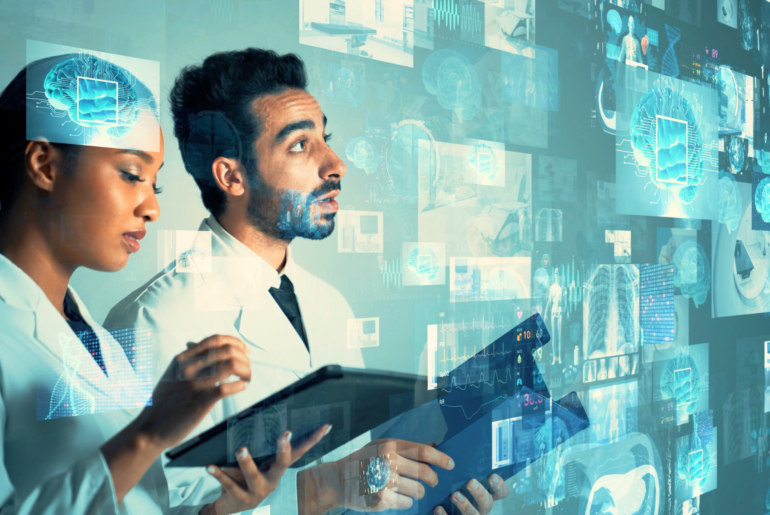The Asia/Pacific healthcare sector is at a pivotal moment, as the industry is transitioning from just ‘care anywhere’ to ‘AI everywhere in care management’ phase. This essential transition is supported and driven by the focus on robust clinical data sets and evolving connected care ecosystem. To efficiently manage the care delivery process, care providers are prioritizing enhancing clinical, operational and administrative workflow productivity.
As a result, GenAI has emerged as a transformative force, with a huge potential to revolutionize the future of healthcare workflow processes and care delivery system.
Dedicated Budget for Generative AI, Initial Investments Focused on PoCs
IDC’s recent survey shows that in Asia/Pacific over half of healthcare and life science organizations are planning to have a dedicated budget for GenAI. IDC data also shows that almost 40% of healthcare providers and nearly a third of life sciences firms in the region are currently focused on proofs of concept (POCs) of GenAI models as part of testing tools and solutions. This trend is mainly owed to the nascent stage of tech adoption and to the testing of the scalability and partnership ecosystem by healthcare organizations.
GenAI adoption is set to create a positive impact on clinician experience, patient engagement, and workflow efficiency management for healthcare provider organizations. In life sciences, the initial impact will be mostly on drug discovery and design, enhanced patient engagement, streamlined clinical trials, and patient safety. Data is at the core of AI, and this is driving healthcare organizations to increase their focus on EHRs and investments on cloud adoption to make their digital infrastructure and data platforms more robust and secure.
Evolving Partner Ecosystem
Most healthcare and life sciences organizations are of the opinion that GenAI models that leverage their own business data will give them a significant advantage over competitors. Those with mature and secure clinical data foundations, such as multi-cloud and hybrid cloud architectures are better positioned to take full advantage of GenAI at a faster pace. At the same time, the focus on data security has increased as the healthcare sector faces intense threats through cyberattacks. As a result, the GenAI ecosystem involves IT SPs, security and platform providers, and hyper-scalers in solution deployments.
Time to Align GenAI Use Cases for Healthcare Organizations
As the demand for GenAI intensifies, healthcare and life science organizations in the region are shifting their focus towards healthcare-specific GenAI use cases. To accommodate this demand, IDC recently released a study documenting GenAI use cases in the healthcare provider segment GenAI Use Case Taxonomy, 2024: The Healthcare Industry, and life sciences sector GenAI Use Case Taxonomy, 2024: The Life Sciences Industry, addressing business impact, metrics, and data modality for each use case.
Current GenAI case study deployments in the Asia/Pacific region predominantly address clinical documentation and summarization, content creation for clinician-to-patient communication, personalization of patients/consumer experiences, patient engagement, and drug discovery and design. These use cases are set to accelerate personalization, care experience, and workflow productivity.
Challenges on the Journey to GenAI Adoption
The journey to GenAI adoption is not without risks. Regulatory risks and higher infrastructure costs are the limiting factors for GenAI adoption among healthcare and life sciences organizations in the region. Organizations will carefully consider tech partnerships and align use cases to implement GenAI solutions effectively and safely. IDC data shows that healthcare CIOs expect a software provider to have robust data security, seamless and intuitive AI models to work with, and GenAI models that support a broad range of content, both structured and unstructured
Road Ahead
Moving ahead, creating a robust clinical data foundation, aligning GenAI use cases between organizational priorities with that of the tech providers’ offerings, and exploring flexible pricing options, along with trust and transparency in the solution engagement would ensure a smooth transition of GenAI use case deployments from PoCs into production.
GenAI adoption in healthcare and life sciences, though at its nascent stage, is set to have a significant impact on enhancing clinician efficiency, improving workflow productivity, and hyper-personalization of patient experience. Currently, there is increased priority towards POCs as part of GenAI model deployments but this is set to transition to full-fledged deployments supported by matured clinical data sets, regulatory support, enhanced skill sets, clinician buy-in, and alignment of GenAI use cases with organizational priorities.
For additional reference, please access IDC Health Insight’s report GenAI in Healthcare and Life Sciences: Current Trends and Future Potential in Asia/Pacific.
Learn what matters most to your customers with IDC’s AI Use Case Discovery Tool—find out more.




